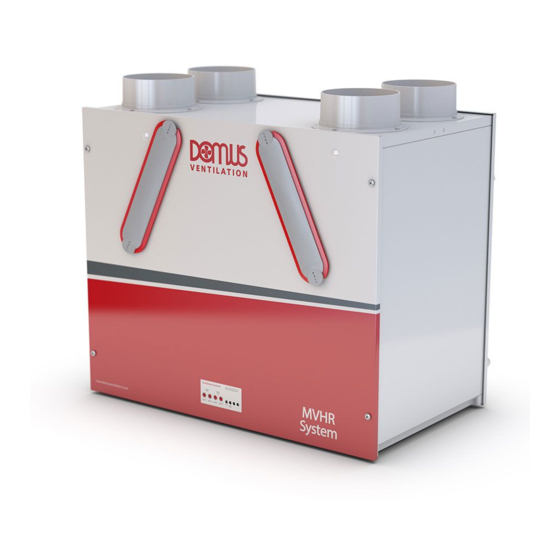Domus Ventilation HRXE-OPH Kurulum Talimatları Kılavuzu - Sayfa 3
Fan Domus Ventilation HRXE-OPH için çevrimiçi göz atın veya pdf Kurulum Talimatları Kılavuzu indirin. Domus Ventilation HRXE-OPH 8 sayfaları. Mechanical ventilation units with heat recovery

2.6 Condensate Drain
Domus Ventilation recommend part 397 be used as the primary
condensate take-off (see figures 9 & 10).
• If the condensation pipe is fitted in an unheated space the pipe should
be in insulated to prevent freezing.
9
Part 397 option: Condensate drain and pipe, uninsulated drain pipe
with minimum 5° fall running to SVP
10
397
To unit
Connecting 5697 Drainage and 397 Drain with "T" Piece
When using a "T" Piece to connect the 5697 drainage and the
397 drain pipework, the 397 drain must always be fitted before
the "T" Piece to prevent condensate from feeding back into the
MVHR system.
2.7 Extract / Supply Areas
The unit is designed to extract air from all wet rooms e.g. bathroom,
kitchen, en suite, utility room (with sink). W.C.'s do not need to be
ventilated if openable windows are fitted.
Supply air should be to all habitable rooms e.g. bedrooms and lounge.
Extract / input grilles should be adjustable valve types (not supplied).
External grilles are to have a minimum free area of 12,250 mm
2.8 Ducting
Before commencing ducting installation reference should be made
to building regulations document "Domestic ventilation compliance
guide". This document supports ADF2010 and details installation,
testing and commissioning of all ventilation systems.
LAB1355R | SEPTEMBER 2018
Collar
To 5697
Condensation
Trap
To SVP
"T" piece
It is recommended that rigid ducting be used at all times. Flexible
ducting has a very high resistance and it is impossible to calculate how
much resistance will be on a system if used. If used the flexible ducting
must be kept to a minimum and should always be pulled taut. A
maximum of 300mm should be used on each leg.
To prevent condensation on the outside of the outside air inlet duct and
the air outlet duct from the unit, these ducts should be insulated.
Ducting must be installed in such a way that resistance to airflow is
minimised. Bends should be kept to a minimum.
A minimum distance of 300mm between the appliance and any bends
in ductwork is recommended.
Ideally 125mm diameter or 204 x 60mm rectangular ducting should
be used (Refer to typical ducted arrangements, see figures 12 & 13 on
page 5 for further information).
Ducting joints must be sealed with silicone type sealant such as DDSEAL,
and shall be adequately and reliably fixed to the appliance.
2.9 Ventilation Flow Rates
Before commencing ducting installation reference should be made
to building regulations document "Domestic ventilation compliance
guide". This document supports ADF2010 and details installation,
testing and commissioning of all ventilation systems.
Room
Kitchen
Utility Room
Bathroom
Sanitary
Accommodation
Table 1: ADF 2010 - Extract Ventilation Rates
Whole
Dwelling
Ventilation
Rate (l/s)
1,2
Notes:
1. In addition, the minimum ventilation rate should be no less
than 0.3 l/s per m
e.g. for a two-story building add the ground and first floor areas).
2. This is based on two occupants in the main bedroom and a
single occupant in all other bedrooms. This should be used as the
default value. If a greater level of occupancy is expected add 4 l/s
per occupant.
IMPORTANT
Any air intake terminal MUST be installed in accordance with the
.
2
appropriate regulation.
As a guide, the BS5440 series of British Standards deals with this
issue and currently states that an air intake must be at a minimum
distance of 300mm from a gas boiler balanced flue.
Installers are advised to be aware of the requirements of this
standard when installing 'through the wall' supply air ducting.
Min High Rate
13 l/s
8 l/s
8 l/s
6 l/s
Number of Bedrooms in Dwelling
1
2
13
17
Table 2: Whole Dwelling Ventilation Rates
of internal floor area (This includes all floors,
2
Min Low Rate
Total extract
rate should
be at least the
whole dwelling
ventilation rate
given in table 2.
3
4
5
21
25
29
PAGE 3
